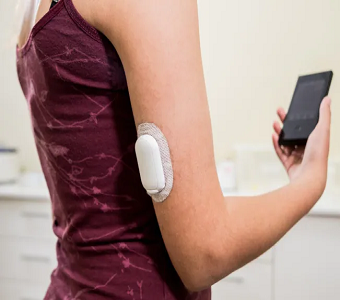The first seismic shift in diabetes care played out during the last six years when continuous glucose monitoring (CGM) became a norm for diabetes patients relying on mealtime insulin. This created multi-billion-dollar businesses for Dexcom (DXCM), Abbott (ABT) and Medtronic (MDT). A second shift is underway and is expected to playout over the next six years as diabetes patients look to combine CGMs with insulin delivery systems.
Replay of experts discussing diabetes care & insulin pump markets HERE
Diabetes’ First Market Shift
A continuous glucose monitor (CGM) is a wearable technology consisting of a sensor placed just under the skin that automatically tracks glucose levels throughout the day. People living with diabetes historically relied on a finger-prick test for each reading. This method was inconvenient, outdated and even painful after several pricks each day. CGM technology allows users to observe their glucose levels anytime at a glance, review changes over time, and see trends. In short, it helps patients manage and engage with diabetes better.
In September 2017, the FDA approved Abbott’s Freestyle Libre glucose monitoring system. Although the Libre was not the first CGM to market, within a six-year period, it became a $4B device with nearly 4.5M users atop the continuous glucose monitoring market. During this time, the CGM market as a whole surged, driven by greater uptake among both type 1 and 2 diabetes patients. Even with Abbott’s incredible launch, existing CGM players saw comparable success. Dexcom revenues rose from $720M in 2017 to an expected 3.5B in 2023 and Medtronic diabetes care became a $2.2B category for the medical device giant.
Global revenues from the top CGM players are projected to hit $9.5B this year.

Simplicity and affordability expanded the product category beyond early adopters
A significant portion of increased CGM use was facilitated by Abbott’s Libre which introduced an option for casual diabetes patients. Existing players Dexcom and Medtronic offered complex, full-featured devices designed for sophisticated patients motivated to manage their diabetes. Abbott, on the other hand, offered a cheaper, easy to use device that many diabetes patients could afford to buy directly from the pharmacy (with a provider's prescription) without going through their insurance. Abbott’s estimated $160/month price undercut Dexcom, which was in the $500/month range and Medtronic’s $400/month.
Libre entered the market as a simple device that did not have all the bells and whistles of competitors. This simplicity appealed to the casual diabetes patient that wanted the bare minimum and had no time nor interest in engaging with their diabetes. There were CGM devices for all user types; Abbott’s Freestyle Libre for casual users and Dexcom/Medtronic for the most motivated and sophisticated cohort of patients. As a result, CGM became widely adopted amongst diabetics.
Segment Summary: Abbott entered the CGM market as a latecomer with an accessible & affordable device for casual diabetes patients. Abbott’s Libre was an alternative to Dexcom and Medtronic feature-rich devices. As a result, patients of all sorts had different options which translated to increased CGM adoption and made the technology a standard of care in diabetes.
The Ongoing Second Market Shift
People who need intensive insulin therapy (IIT) are those whose insulin regimen includes mealtime insulin via injection. In the US, this population includes all Type 1 diabetics (1.6 million) and about 7.4% of Type 2 diabetics (2.4 million) for a total of 4 million IIT patients.
In the top 25 markets, the number of IIT patients is around 7 million. Around 70% of them are already using a CGM solution, as seen below.

Over the next six years, the standard of care will include smart dosing that combines CGMs with insulin pumps and pens that are able to deliver insulin when needed. Currently, most diabetes patients manually inject insulin with a syringe a few minutes before a meal. Smart dosing systems, such as using pumps, would add a convenience factor that replaces the daily manual injections while better managing blood sugar levels near normal ranges.
At the 2023 American Diabetes Association this past June, Medtronic shared expectations for diabetes care into 2030. Medtronic believes that over the next six years, insulin pumps will see increased adoption as more diabetes patients move to smart dosing systems that include using a CGM monitor in tandem with insulin pumps and insulin pens.
Currently at 20% penetration, Medtronic sees insulin delivery hitting 65% adoption among the IIT patient population. That’s approximately 4.6M total users worldwide. Today this number is 1.3M, so Medtronic expects about 3M diabetes patients to convert into pump users over the next 6 years.
Segment Summary: Medtronic projects smart dosing (ie. insulin pumps and pens) to see increased adoption and become the standard of care delivery systems by 2030. According to Medtronic projections, this tailwind could convert approximately 3M diabetes patients over the next 6 years, or 3.5x the current userbase.
Widespread Pump Adoption Will Need Casual & Sophisticated Diabetes Patients to Buy In
Just like with CGMs before them, widespread adoption of insulin delivery systems will need pumps tailored for:
- casual patients not interested in technical know-how or with the financial means
- the sophisticated users that want all the bells and whistles
Tandem (TNDM) and Medtronic (MDT) sell feature-rich, expensive ($4,000 range) pumps using a durable medical equipment (DME) sales model. While these pumps have seen traction with the dedicated diabetes patient, they seem to be hitting a plateau. In FY 2023, Medtronic’s diabetes segment only saw a 2.4% year-over-year rise in organic topline. Tandem cut their FY 2023 sales guidance from the original $900 million to $785M, a 2% decline from their FY2022 sales figure. Both businesses are seeing growth stagger.
Insulet (PODD) is the third major insulin pump player and they’re seeing the opposite. Insulet raised 2023 revenue outlook to 22%-25% (previous 18-22%). The majority of this revenue growth is coming from their Omnipod 5 pump, which is capturing pump users from competing Tandem and Medtronic, while also growing pump adoption from patients using manual injections.

Insulet’s Omnipod 5 pump has distinguished itself in two ways:
- a tubeless (“patch”) pump, compared to traditional tubed (“durable”) pumps offered by Medtronic and Tandem.
- Pay-as-you go business model with no upfront cost. Charges only for consumables. This qualifies Omnipod as a Pharmacy Benefit Management (PBM) product, which is appealing to patients, payors and brings easier reimbursement. Conversely, Medtronic and Tandem pumps have upfront costs that qualify them as durable medical equipment (DME), making them more difficult for reimbursement purposes.

Medtronic & Tandem Are Aware They’re Falling Behind
Tandem and Medtronic are attempting to address the glaring holes in their product lineups by making bolt on acquisitions that will give them patch pumps. In December 2022, Tandem purchased AMF Medical, maker of Sigi Patch Pump, for up to $212M, including milestones and earnouts. The Sigi Patch Pump is in pre-clearance with submission expected by late 2026. In May 2023, Medtronic announced the acquisition of EOFlow for $738M. EOFlow makes a patch pump similar to Insulet’s Omnipod. It is cleared in over 10 countries globally, but not yet approved in the US. EOFlow submitted a 510(k) to the NDA in December 2022 and generated approximately $5M in device sales in other countries.
Both companies are seeing Insulet’s outperformance and are pivoting to patch pumps stay competitive. However, their recently acquired patch pumps are not yet cleared by the FDA in the US market, meaning that Insulet will remain unchallenged in the near term.
Segment Summary: Insulet, Tandem and Medtronic are the three dominant insulin pump players. Tandem is outperforming the other two competitors by offering a patch pump and utilizing a prescription drug benefit model that simplifies reimbursement.
Pump Tailored for Casual Diabetics Remains an Unmet Opportunity
Patch pumps are a step in the right direction, but a simpler device for casual diabetes patients is still missing for insulin delivery. Tandem, Medtronic and Insulet’s pumps are elaborate products with enhanced features that require extensive training. A straightforward solution with minimal management effort is needed to hit 65% penetration among IIT patients, as Medtronic projects. This is the target market Modular Medical (MODD) is trying to meet with their MODD1 pump.
Inspired by Abbott’s success in CGM, MODD is developing an insulin pump with basic functionality that results in simplicity and ease of use, while offering a lower cost to payors and patients (video on ease of use here). The company will employ a pay-as-you go pharmacy benefit model, similar to Insulet’s commercial playbook, as it will have no upfront cost for the device but charge only for disposables which should simplify reimbursement.

Segment Summary: A simple and affordable insulin pump is still an untapped market for casual diabetes patients. Modular Medical is developing an insulin pump that is inspired by Abbott’s simplicity playbook and Insulet’s commercial approach to have $0 upfront cost for the device but charge only for disposables which should simplify reimbursement.
MODD1 will be submitted for FDA clearance by the end of 2023, with an anticipated FDA approval by mid-2024. Modular Medical will be launching MODD1 into a market that is embracing simplicity while also facing tailwinds of a growing segment in insulin delivery.
MODD trades at a $22M market cap, likely because it is still pre-clearance and has experienced several delays with their FDA submission. The planned 510(k) filing with the FDA by year end 2023 could prove to be a catalyst that ignites interest in the company as it would put MODD one step closer to commercialization and restore credibility by overcoming the submission hurdle that has paused progress.
The market has shown that insulin pump companies come with lush price tags. Insulet (PODD), the market leader, trades at 10x sales and approximately 120 operating earnings. Tandem acquired AMF Medical for up to $212M and Medtronic spent $738M for EOFlow. With the 510(k) filing by year end and potential FDA clearance 6 months later, the market might start to value MODD at multiples higher than the current market cap.
Bottom Line: In the last 6 years, CGM market as a whole surged, driven by greater uptake among both type 1 and 2 diabetes patients. This created multi-billion-dollar businesses for Dexcom, Abbott and Medtronic. The second, ongoing seismic shift in the adjacent insulin delivery market could yield similar results whereby the whole segment rises due to increased adoption. Investors have options to participate through PODD, the current market leader, TNDM or MDT as pivot stories or MODD, the fast follower.
PropThink contributors do not hold positions in any of the names mentioned in this note.
Disclaimer:
PropThink has been previously compensated fifteen thousand dollars by Modular Medical Inc. ("Company") for conceptualizing, marketing and hosting a digital conference. The prior compensation forms a bias to remain objective in our communication regarding Modular Medical Inc. PropThink has not been compensated for additional content of Modular Medical Inc.. PropThink is not a registered investment advisor in any jurisdiction. We do not publish investment advice and remind readers that investing involves considerable risk. PropThink urges all readers to carefully review the Company's regulatory filings and consult with an investment professional before making any investment decisions. Please read our full disclaimer at https://propthink.com/disclaimer
Access This Content Now
Sign Up Now!




